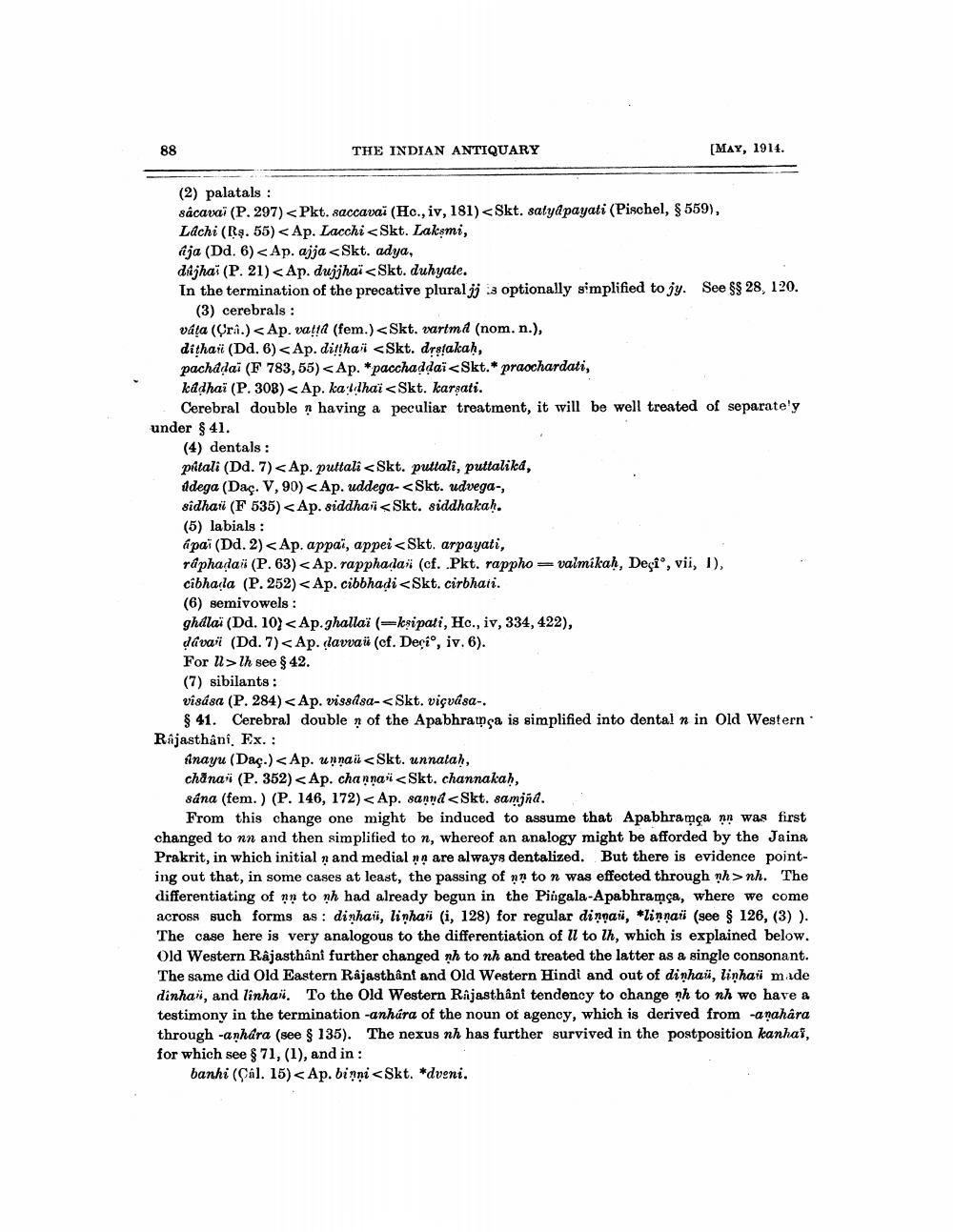________________
88
THE INDIAN ANTIQUARY
(2) palatals:
sâcavai (P. 297) <Pkt. saccavaï (Hc., iv, 181) <Skt. satyapayati (Pischel, § 559),
Lachi (Rs. 55) < Ap. Lacchi <Skt. Laksmi,
ája (Dd. 6)<Ap. ajja <Skt. adya,
dujhai (P. 21)<Ap. dujjhaï <Skt. duhyate.
In the termination of the precative plural jj s optionally simplified to jy. See §§ 28, 120. (3) cerebrals:
váta (Crâ.)<Ap. vatta (fem.) <Skt. vartma (nom. n.),
dithai (Dd. 6)<Ap. ditthai <Skt. drṣṭakaḥ,
pachaḍai (F 783, 55) <Ap. *pacchaddai <Skt.* praochardati,
[MAY, 1914.
kadhai (P. 308) <Ap. kadhai <Skt. karṣati.
Cerebral double ? having a peculiar treatment, it will be well treated of separate'y under § 41.
(4) dentals:
pitali (Dd. 7) <Ap. puttali <Skt. puttali, puttalika, údega (Daç. V, 90) <Ap. uddega- <Skt. udvega-, sidhai (F 535) <Ap. siddha<Skt. siddhakaḥ. (5) labials:
ápai (Dd. 2)<Ap. appai, appei<Skt. arpayati,
raphaḍai (P. 63) <Ap. rapphaḍa (cf. .Pkt. rappho valmikaḥ, Deçî°, vii, 1),
cibhada (P. 252) <Ap. cibbhadi <Skt. cirbhati.
(6) semivowels:
ghálai (Dd. 10)<Ap.ghallai (=kṣipati, Hc., iv, 334, 422),
davan (Dd. 7)<Ap. davva (cf. Deci, iv. 6).
For l>lh see § 42.
(7) sibilants:
visása (P. 284) <Ap. vissása- <Skt. viçvása-.
§ 41. Cerebral double n of the Apabhramça is simplified into dental n in Old Western Rajasthânî, Ex.:
inayu (Daç.)<Ap. unnai <Skt. unnataḥ,
chana" (P. 352) <Ap. channa" <Skt. channakaḥ,
sána (fem.) (P. 146, 172) < Ap. sannd<Skt. samjná.
From this change one might be induced to assume that Apabhramça nn was first changed to nn and then simplified to n, whereof an analogy might be afforded by the Jaina Prakrit, in which initial and medial nn are always dentalized. But there is evidence pointing out that, in some cases at least, the passing of nn to n was effected through nh>nh. The differentiating of nn to nh had already begun in the Pingala-Apabhramça, where we come across such forms as: dinha, linha (i, 128) for regular dingai, *linna (see § 126, (3) ). The case here is very analogous to the differentiation of ll to lh, which is explained below. Old Western Rajasthânî further changed nh to nh and treated the latter as a single consonant. The same did Old Eastern Rajasthânt and Old Western Hindi and out of dinhau, linhaï made dinha, and linha. To the Old Western Rajasthânî tendency to change nh to nh we have a testimony in the termination -anhúra of the noun of agency, which is derived from -anahâra through -anhara (see § 135). The nexus nh has further survived in the postposition kanha, for which see § 71, (1), and in :
banhi (Çâl. 15)<Ap. binni <Skt. *dveni.




